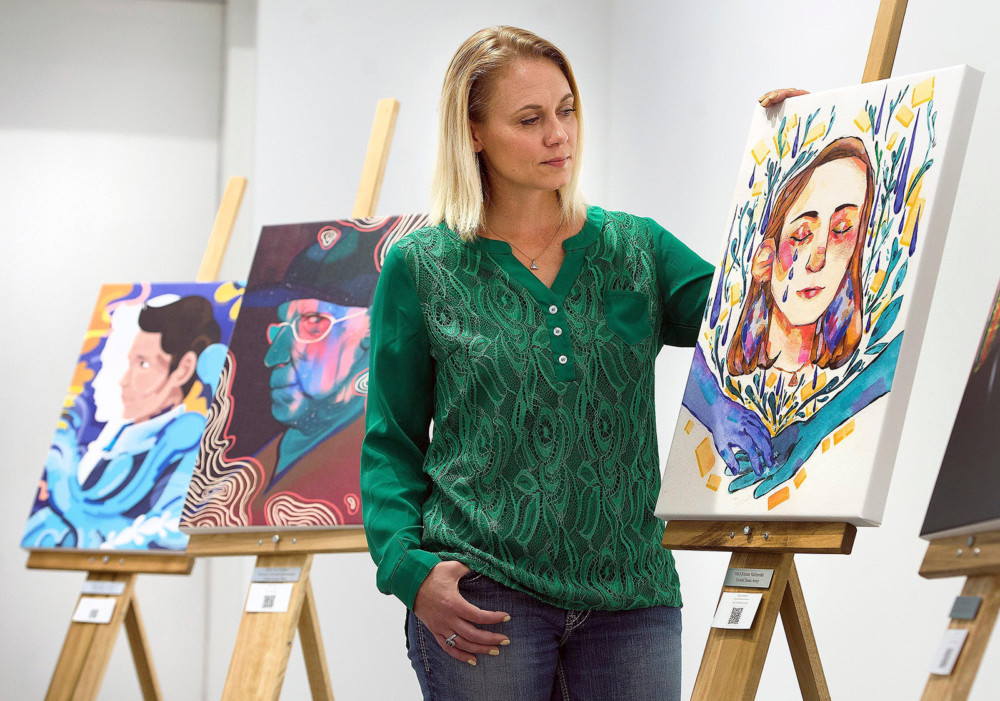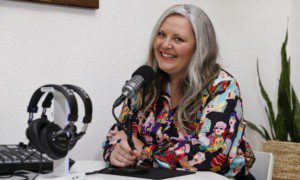By Skyler Rossi
The Kansas City Star
WWR Article Summary (tl;dr) “Veteran Reflection” tells the stories of 14 veterans through portraits done by Art Institute students and audio clips of the veterans in their own words.
The Kansas City Star
Kirsten Vallinmaki, a military intelligence officer of almost 21 years, struggled to feel normal after she was stationed overseas and stateside.
Like many other veterans, she felt isolated when she returned home, even when she was surrounded by people who loved her, including her two sons.
“Social isolation and loneliness is a very real thing and it’s something that’s often misunderstood and ignored,” said Vallinmaki, who uses her previous last name, Hesterberg, in the military.
It’s hard to express and process emotions, she said, and it’s even harder to understand if you haven’t been in the military. The only way for other people to begin to understand is through listening to the stories veterans have to tell, she said.
That’s the premise of “Veteran Reflection,” a Kansas City Art Institute exhibit that aims to give a voice to the loneliness and isolation many veterans feel.
The exhibit tells the stories of 14 veterans, including Vallinmaki’s, through portraits done by Art Institute students and audio clips of the veterans in their own words. The audio is accessed by scanning a QR code with a smartphone.
Growing up in foster care, Vallinmaki said she didn’t have a constant and reliable form of support, other than the foster mom she met when she was a sophomore in high school and is still in her life. She turned to the Army as a way to get out of the system and found a place where she felt she belonged.
But integrating back into regular life was challenging.
She said the best way for veterans to heal after coming home is through conversation and opening up about their raw emotions, which can sometimes be difficult. For her, she found havens in church and a therapy program called The Battle Within.
Still serving in the Army Reserve, she said she risks her job each time she talks about her struggles with PTSD. But she still shares her story when she can.
“If it helps one solider seek help to heal, then it’s worth it,” she said.
Seeing the portraits and hearing the interviews, Vallinmaki said, created a reality for the veterans’ stories.
Many of the art students hadn’t spoken to veterans or people in the military before, Vallinmaki said. Students just listening to the veterans’ stories and meeting veterans made them more understanding of the issues of isolation, she said.
Arlan Engin, a recent Art Institute graduate, said she was worried she might overstep during her interviews. She just wanted to be helpful, which she said was a shared feeling among her fellow students.
“They’re just people,” she said. “It’s maybe something a lot of people forget, including us. We didn’t know what to expect.”
Engin told the stories of two veterans, Doc and Sean, through her portraits and audio interviews.
Doc said he felt alone during his service and turned to alcohol to cope when he retired.
“My dream of doing 20 years in the Navy just about took my life,” he shares in his audio clip.
Vallinmaki’s portrait depicts her surrounded by flowers and two hands reaching out to each other. Her eyes are closed and tears are falling down her cheek. That’s because she cried during her interview with the art student, she said.
The exhibit was created as part of the Art Institute’s Sponsored Studio class, which partners with businesses and community organizations to illustrate societal problems creatively. Art Institute representative Kathy St. Clair said the class has covered a wide variety of issues, but this is the first time veterans were the subject.
Students in the class get to choose which project they want to work on, but Humana representative, Lesley Newton said once students heard about this project, they all gravitated to it. Humana, the health insurance company, was one of the main partners in creating the project.
Vallinmaki was drawn to sharing her story with the students because art has played a significant role in her own healing. She said she creates digital, abstract art to express her trauma.
“Art is an amazing way not only for others to understand but for veterans to express themselves,” she said. “You can say things words can’t.”
One veteran who shared his story, identified by his first name Gary, discusses in his audio clip how art saved him after being medically retired from the military. He likes to paint flowers because it “softens the pain.”
“I didn’t think about the pain physically from my back,” he said about painting. “I didn’t think about the pain emotionally. Spiritually, it was an awakening.”
Humana is taking the exhibit around the country, including stops in Orlando, Fla., and Louisville, Ky. It will return to Kansas City on Aug. 19 for two weeks.
Many veterans see the portraits, such as Vallinmaki’s with tears on her cheek, and get emotional because they feel understood, Newton said.
“They’re looking at the portrait feeling the same feelings she most likely was having just by seeing it,” Newton said.
The exhibit makes veterans feel connected, which Newton said was the goal of the project in the first place. Humana wants to provide resources to veterans and national programs that help veterans with feelings of loneliness and isolation, she said.
A soldier doesn’t begin to heal until they cry, Vallinmaki said. This exhibit, and experiencing the stories the 14 veterans shared, is a first step toward that feeling for some.
“I’m not healed,” she said. “I am healing.”
___
Distributed by Tribune Content Agency, LLC.
















































































































































































































































































































































































